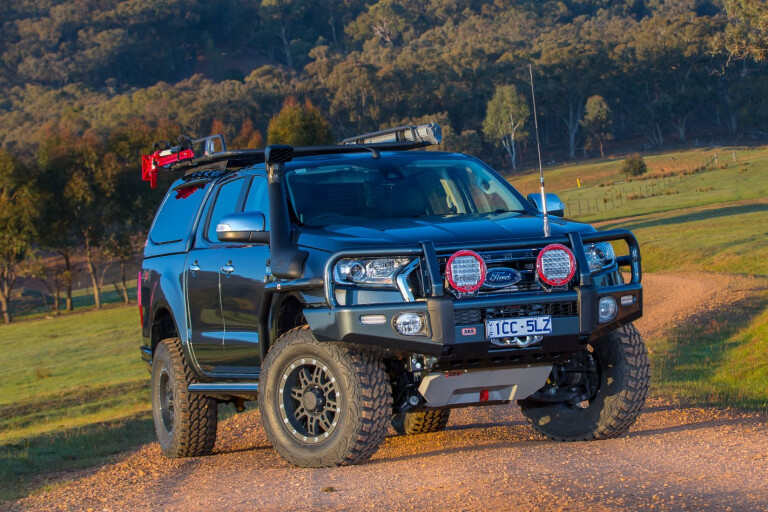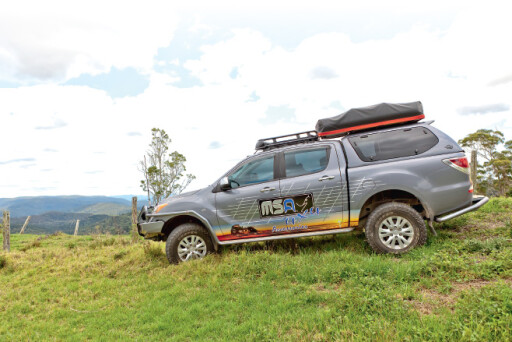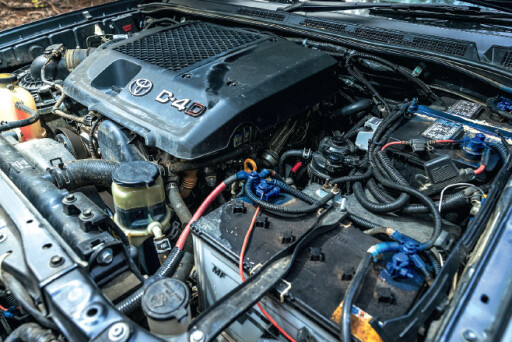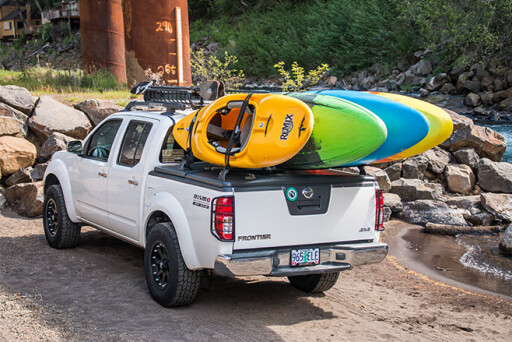
For the past decade or so, dual-cab utes have been smashing it with Aussie buyers.
Many utes roll straight from the boats to the outback as mining and farming rigs. But there has also been an increasing number of private buyers unfurling fat wads of cash to get their hands on their idea of the perfect touring, towing or family rig. New or second-hand, a dual-cab ute has become the vehicle of choice for many of us who enjoy weekend camping or long-term travelling.
And it’s not just the traditional appeals of low pricing, relative simplicity and toughness that make utes a dollars-and-sense choice for touring. Utes are now better built, better equipped and more capable off-road than ever. With leaps and bounds in off-road performance thanks to traction control and ever-more responsive engines and drivelines, most are a no-compromise alternative to traditional wagons – that long, wide, deep tub behind the passenger compartment is the perfect platform for a top tourer.
 When setting up a bush/outback tourer, most of the same guidelines apply for any vehicle, whether it’s a wagon or ute. For equipment such as upgraded wheels and tyres, frontal and underbody protection, and suspension, there is a stack of Aussie aftermarket brands offering complete catalogues of equipment, from nose to tail. So let’s get down to the nitty-gritty.
When setting up a bush/outback tourer, most of the same guidelines apply for any vehicle, whether it’s a wagon or ute. For equipment such as upgraded wheels and tyres, frontal and underbody protection, and suspension, there is a stack of Aussie aftermarket brands offering complete catalogues of equipment, from nose to tail. So let’s get down to the nitty-gritty.
TAKE COVER
With a bare tub in your straight-off-the-showroom-floor ute, you have ultimate freedom in equipment selection. There’s nothing to stop you throwing a swag, water drum, cup, plate, fork and tucker box in to the back of your ute to head bush – and many experienced travellers choose to travel light. But with the range of equipment on offer, you can have a little more comfort and convenience.
One of the first considerations – sometimes even before you’ve received the keys to your brand-new ute – is the choice of a tub liner, canopy, hard lid, or racking. Your choice here will be determined largely by how you will use your ute, in what conditions and over what terrain. If your idea of fun is lugging a couple of dirt bikes into a state forest every second weekend, you’ll want things set up differently to someone who intends to use their ute as a work rig all year before the annual desert trek holiday.
.jpg ) Hard lids have their applications, but a canopy is generally a more popular choice for touring. Canopies provide weather protection and basic security for your equipment. Dual-cab ute passenger compartments are usually more dust-proof than those of wagons – wagon tailgates are notorious for letting in dust – but the load area of a ute isn’t dust-proof, even with a canopy attached. Being separate from the cabin, it’s not pressurised, and the tailgate is missing the rubber seal of a wagon. These days, there are several aftermarket suppliers of dust-seal kits that will reduce or eliminate dust entry.
Hard lids have their applications, but a canopy is generally a more popular choice for touring. Canopies provide weather protection and basic security for your equipment. Dual-cab ute passenger compartments are usually more dust-proof than those of wagons – wagon tailgates are notorious for letting in dust – but the load area of a ute isn’t dust-proof, even with a canopy attached. Being separate from the cabin, it’s not pressurised, and the tailgate is missing the rubber seal of a wagon. These days, there are several aftermarket suppliers of dust-seal kits that will reduce or eliminate dust entry.
Canopies are available in steel or composite construction (generally colour-matched to the vehicle) and can be fitted with fixed, sliding or lift-up windows. Sliding windows can be fitted with security mesh to allow a breeze in when the vehicle is unattended; lift-up windows offer easier access for loading, especially to the forward section of the load area.
Tub liners are a great idea for a work truck – or for those sometimes grubby hobbies such as motorbike riding – but they can make installing touring hardware, such as drawers, fridges and water tanks, a little more difficult than with a standard steel tub. Most new-vehicle dealers will offer an optional tub liner for protection and, of course, there are aftermarket ones, too.
Moulded liners need to be installed before a canopy, but paint- or spray-on polyurethane protection – another smart choice for a working truck – can be applied later. Marine or other industrial-grade carpet can be installed, too.
POWER TO THE PEOPLE
There aren’t too many of us who travel without a fridge and camp lighting these days, so having 12V power available in your vehicle’s tub – which is also often the kitchen area when you’re travelling – is usually a priority. Power supply requirements should be considered early in the vehicle’s build, before routing of wiring becomes difficult due to the fitting of a tub liner or canopy.
Because of restricted engine bay space, some vehicles need the second battery (for operating a power-hungry fridge overnight) mounted in the load area. Batteries, in general, last longer when they are kept cooler, and some battery types do not cope at all with the high heat of an engine bay. Most present-model vehicles with variable voltage charging will require supplementary hardware such as a DC-DC charger. The location of this hardware will need to be considered, too.
 No matter what the ‘never-had-a-problem’ Facebook experts reckon, the second/dual battery wiring must be protected with circuit breakers or fuses adjacent to all batteries. This will prevent a short circuit (due to accidental wiring damage) from burning your new rig to the ground.
No matter what the ‘never-had-a-problem’ Facebook experts reckon, the second/dual battery wiring must be protected with circuit breakers or fuses adjacent to all batteries. This will prevent a short circuit (due to accidental wiring damage) from burning your new rig to the ground.
Depending on what accessories you plan to use, there are a wide range of suitable plugs and sockets that can be wired up to fire up your equipment, from old-school ciggy lighter plugs to USB ports for charging electronic equipment.
To make life easier for your second/accessory battery, it’s also a good idea to charge while you are travelling – when your vehicle’s engine and charging system is operating – and not when you get to camp each evening.
WEIGHT OF THE WORLD
A roof rack is handy, even if it’s only used to install a side-mounted roll-out awning. Vehicles being set up for longer treks will often have stronger roof racks for carrying a second spare tyre. Once again, the intended use (or the weight it will carry) is an important factor in choosing what you need. It’s important not to exceed the vehicle’s rating or canopy’s rating for weight. Some canopies are built strong enough for a decent roof load – in excess of 100kg – while others are lighter (often a bonus when every kilo counts) but require internal reinforcing bars for heavy roof loads.
 Open load-area racks are popular, too. They allow the space above an open tub to be used to carry items such as recovery boards and roof-top tents, while keeping most of the tub free for tools or camping equipment. They don’t have the security and dust-resistance of a canopy, but they provide a gear-carrying alternative, especially for vehicles being set up for weekender-type treks.
Open load-area racks are popular, too. They allow the space above an open tub to be used to carry items such as recovery boards and roof-top tents, while keeping most of the tub free for tools or camping equipment. They don’t have the security and dust-resistance of a canopy, but they provide a gear-carrying alternative, especially for vehicles being set up for weekender-type treks.
Usually integrated into a rear protection and tow/recovery bar, swing-away tyre carriers allow a second and third spare wheel – or extra fuel – to be carried on the vehicle’s rear. This can be convenient when the tyre or fuel is needed (it’s a little lower and easier to access than a roof rack), but keep in mind the spares must be swung clear of the tailgate every time you need something – such as a cool drink or lunch – from the rear of the vehicle.
Installed to the chassis the same way as a towbar, the equipment and accessory weight needs to be taken into consideration for both overall carrying capacity and tow ball download.
DRAWERS AND STORAGE
Not long ago, 4WD drawers were the carefully crafted products of specialist vehicle outfitters. But these days, there’s more choice than ever, and it’s possible to buy universal-fit drawers from the local hardware warehouse. There’s also a wide range of materials used in their construction – and a wide range of quality, too.
Some drawer kits are remarkably strong and some are remarkably heavy, even when empty. Something else to think about is the roller-element drawer slides used for some drawers and fridge slides – they may not enjoy the dusty, gritty environment in the rear of a ute.
 Some drawer set-ups feature removable boxes that make trip preparation – and use at camp – more manageable. The boxes can be lifted out for easier packing and use away from the vehicle. They’re also a good choice for tradies – put your tools in one set of boxes and camping gear in another. Too easy!
Some drawer set-ups feature removable boxes that make trip preparation – and use at camp – more manageable. The boxes can be lifted out for easier packing and use away from the vehicle. They’re also a good choice for tradies – put your tools in one set of boxes and camping gear in another. Too easy!
As with most other aspects of vehicle preparation, you get what you pay for – and sometimes you’ll keep paying for what you get!
Remote-area travel can throw life-threatening situations at you if something goes wrong, so when choosing products for your rig, it’s worth getting durable equipment of a decent quality that’s within your budget, rather than packing your vehicle full of shiny junk that you got for a ‘good price’.

COMMENTS